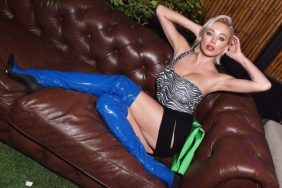Photo: Jacqueline Susann in Central Park. © ZUMA Press, Inc. / Alamy.
“Where would fashion be without literature?” Diana Vreeland asked in D.V., her legendary memoir published in 1984. One to pay homage where it is due, Vreeland understood this it is not just the sartorial splendors of the characters that writers have graced us with over the years, but the very nature of the author’s personal style that has influenced the our tastes and sensibilities.
Also: “Dandy Lion” Roars to Life in a Glorious New Book of Black Male Style
Consider Mark Twain’s white suits versus those of Tom Wolfe, or the lavender ascots and fanciful hats of Quentin Crisp. Reflect on the penchant for men’s wear shared by Fran Lebowitz and Colette in contrast to the flamboyant Victorian get ups of Oscar Wilde. Contemplate the brunette bouffant of Jacqueline Susann, the glorious dreadlocks of Toni Morrison, and the crisp thatch of white hair on Susan Sontag versus the signature beard of Ernest Hemingway.


Terry Newman pulls it all together in the new book, Legendary Authors and The Clothes They Wore (Harper Design), a charming collection that reveals style is more than a way of dressing: it is a state of mind. The book includes chapters of icons from Patti Smith and William S. Burroughs to Marcel Proust and Zadie Smith, along side special sections on signature looks including glasses, suits, hair, and hats of everyone from Robert Crumb and Allen Ginsberg to Bret Easton Ellis and Edgar Allen Poe.
At the heart of it all, the words of Hunter S. Thompson ring true: “Play your own game, be your own man, and don’t ask anybody for a stamp of approval.” This is the very essence of the nature of art: the continuous push of boundaries rooted in deep authenticity. Style, whether it takes literary or sartorial form, is a profoundly idiosyncratic expression of self; the more it becomes clarified, the richer it becomes.
“When you know who you are, you can do it, you can be it, you can be seen as yourself,” Quentin Crisp said at the age of 90. “That’s the point. You first have to find who you are. Then you have to be it like mad.”
This visceral sense of integrity is consistent throughout the book, as literature is one of the most profound expressions of self. To do it—and do it well—one must be naked on the page, moving between the curious space of coquettish, vulnerable, and repulsive. Truth is rarely pretty, yet once you have a taste for it, it’s hard to look away.
Newman does a marvelous job of integrating the various writers’ work in all its forms, from their practices that gave birth to masterpieces to the ways in which their sense of dress was part of the larger distillation of self. In that way, the portraits of the authors presented in the book do as much to serve their writing as their very words.
“Fashion is what one wears oneself, Oscar Wilde opined. “What is unfashionable is what other people wear.” Wilde’s words are an exquisite reminder of the words of the Bard, whether crafting a sentence or an outfit, “to thine own self be true.”
All photos: from the book: LEGENDARY AUTHORS AND THE CLOTHES THEY WORE by Terry Newman. Text © 2017 by Terry Newman. Reprinted courtesy of Harper Design, an imprint of HarperCollins Publishers.
Miss Rosen is a journalist covering art, photography, culture, and books. Her byline has appeared in L’Uomo Vogue, Vogue Online, The Undefeated, Dazed Digital, Aperture Online, and Feature Shoot. Follow her on Twitter @Miss_Rosen.
Legendary Authors and the Clothes THey Wore
-
"Legendary Authors and the Clothes They Wore" by Terry Newman

Djuna Barnes US novelist and illustrator 1892 to 1982. © Pictorial Press Ltd / Alamy.
-
"Legendary Authors and the Clothes They Wore" by Terry Newman

Joe Orton, Author, 1st March 1967. © Trinity Mirror / Mirrorpix / Alamy.
-
"Legendary Authors and the Clothes They Wore" by Terry Newman

Edgar Allen Poe (1809-1849). © Granger Historical Picture Archive / Alamy.
-
"Legendary Authors and the Clothes They Wore" by Terry Newman

Jacqueline Susann in Central Park. © ZUMA Press, Inc. / Alamy.
-
"Legendary Authors and the Clothes They Wore" by Terry Newman

John Updike (1932-2009). © Granger Historical Picture Archive / Alamy.
-
"Legendary Authors and the Clothes They Wore" by Terry Newman

Legendary Authors and the Clothes They Wore by Terry Newman.








